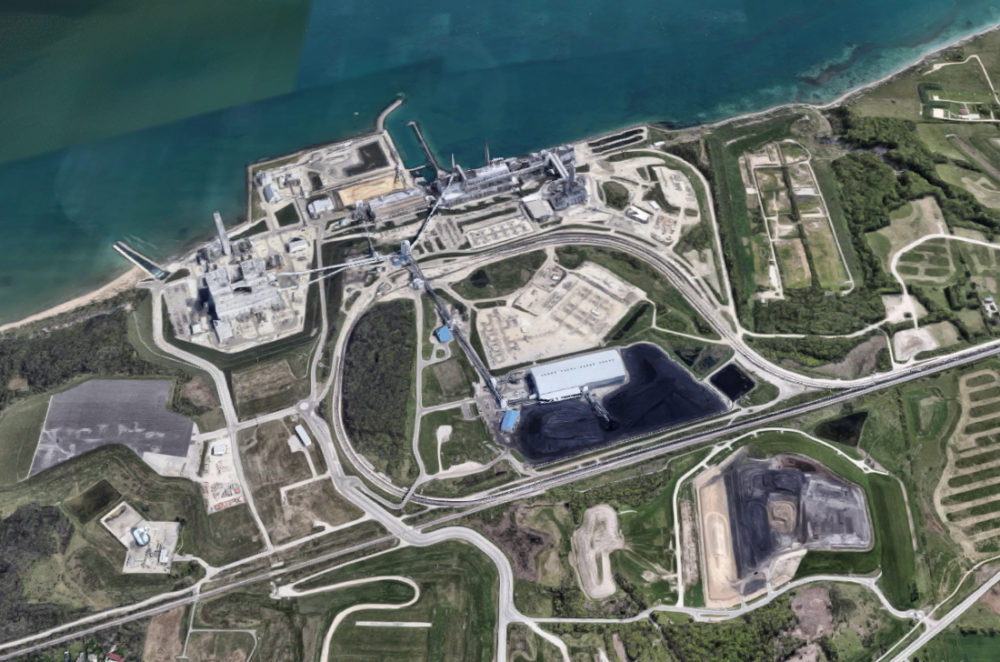Coal Is Literally a Dead End
Pollution from coal used at two Oak Creek power plants has long-term health consequences.

An aerial view of We Energies’ twin Oak Creek and Elm Road coal-fired power plants south of Milwaukee, Wisconsin. Image from Google Earth.
Last month, the Clean Power Coalition of Southeastern Wisconsin hosted a “Listening Session” at the Oak Creek Public Library. Residents were invited to share their experiences and concerns regarding the ongoing problems and recent incidents involving coal dust from the two coal plants in their neighborhood. More than 160 attended, and many spoke passionately about their families’ exposure to coal dust inside and outside their homes. Also attending were representatives from We Energies, which owns one coal plant in Oak Creek and from WPPI and MG&E, the two utilities who co-own the other, newer coal plant with We Energies, known as the Elm Road Generating Station.
Thomas Metcalfe, Executive Vice President for We Energies, spoke of what he called “long-term strategies.” On April 10 a letter went out from him repeating those strategies. Two of them include “Planting more trees for screening” and “Constructing a wind barrier either partially or fully around the coal piles.” Trees? Really? It is difficult to imagine how a row of saplings could shield residents from the mountain of coal next door. This proposed solution is also ironic, given the fact that We Energies chopped down a section of mature forest to make way for the coal pile in the first place.
As for the wind barrier—described as “a large screen that could be as tall as 100 feet”—it is, at best, a partial solution. The material wouldn’t actually block particulates from escaping. It would simply reduce wind speeds in the area around the pile. A 2017 study on coal dust from the National Bureau for Economic Research explains that coal piles emit fine particulate pollution in multiple ways. Wind blowing dust off the pile is one factor, but coal piles also emit volatile gases, which can cause the formation of fine particulates. Additionally, the handling, processing, and pulverization of coal on site can contribute to the problem. The study concludes that these fine particulates, some 2.5 microns or smaller, can travel as far as 25 miles.
Coal dust isn’t the only toxic aspect of coal energy production. Nearly every stage of the process has detrimental impacts on human health and the environment at large–from extraction, to burning, to disposal of coal ash waste with its carcinogenic heavy metal contaminants. In the May/June issue of SIERRA, Sierra Club Director Michael Brune tells us, “Even among dirty fuels, coal causes the most obvious harm to the environment and to human health, from mercury poisoning to black lung disease. Just the soot from coal-fired power plants is responsible for an estimated 13,000 premature deaths annually in the United States.” That’s the equivalent of four 9/11 attacks every year, or one every three months. Yes, every three months.
There is really only one solution: transitioning to clean and renewable energy with all due speed. Fossil fuel energy comes at the price of health. People suffer, particularly children and the elderly. Health is undermined, lives are shortened. The fossil fuel industry has known this for decades. Clean, renewable energy is inevitable. These energy sources—solar and wind—ensure strong, stable jobs, substantial profit and healthier families. And the rest of the world (including many areas of America) is moving in this direction. China, our greatest economic competitor, now leads the world in solar panel production. We can lean into this exciting new transition, or we can stand back as the world passes us by. Finally, clean air, clean water, and uncontaminated soil are human needs. They are environmental needs, earth-needs. And they are every bit as vital for our children and grandchildren and the generations to come.
At the annual shareholders meeting, We Energies CEO Gale Klappa stated that “progress is our most important product.” If that’s truly the case, We Energies needs to embrace progress by eliminating coal from its fuel mix and transitioning to renewable energy. The measures We Energies has suggested so far in response to the concerns of Oak Creek residents are not progress or “long-term solutions”—they’re just more of the same. If Wisconsin’s energy company executives are unwilling to make these changes, then it falls to the shareholders and customers to make their feelings known. Phone calls, letters, and emails encouraging a change of policy will send a clear and compelling message to those in charge. Transitioning to clean, renewable energy makes good business sense, and it’s the right thing to do to protect our health, our people and our planet.
Carl Lindner is a UW-Parkside emeritus professor who lives in Racine.
Op-Ed
-
Wisconsin Candidates Decry Money in Politics, Plan to Raise Tons of It
 Dec 15th, 2025 by Ruth Conniff
Dec 15th, 2025 by Ruth Conniff
-
Trump Left Contraceptives to Rot; Women Pay the Price
 Dec 8th, 2025 by Dr. Shefaali Sharma
Dec 8th, 2025 by Dr. Shefaali Sharma
-
Why the Common Council’s Amended Budget is Good Policy for Milwaukee
 Nov 20th, 2025 by Alds. Marina Dimitrijevic and Russell W. Stamper, II
Nov 20th, 2025 by Alds. Marina Dimitrijevic and Russell W. Stamper, II





















An article published in the April issue, Coal Age Magazine written by J. Joseph Cohen, is an executive scientist at Casimir Systemics LLC. He has designed high-energy laser systems, laser gyroscopes, and developed energy carrier recovery technologies – and more.
Cohen’s piece in Coal Age, titled “The Mythology of Solar Energy” argues that we make assumptions, born of belief, that may mislead us into a “fact space” that may be inconsistent with reality.
A prime example of this problem is that of the “green” movement’s love affair with solar energy. They believe it to be free, plentiful and harmless. Yet it is very complicated, and certainly not as available, economically or environmentally friendly as they would have everyone believe. The sycophants believe that the greenest of the green solution for electrical power are solar photovoltaics (PVs).
What is Solar? Other than heliostat thermal, and PVs, all other derivative solar energy solutions are the result of biological activity, which converts solar irradiance into high-density chemical storage
Cohen goes on to write that “It is convenient to view solar panels as harmless fancy glass windows that with no negative effect, converts the free sunlight into useable electricity. But, they are constructed from a variety of materials and chemicals, which, in their manufacture, harm the environment. Users forget the life cycle involved in harnessing solar energy.
The Author goes on to state that consideration must be given to the fact that the Earth rotates and when it does, darkness occurs, coupled with the fact that since most of the planet is water, there is not enough land to utilize for solar irradiance. In laymen’s terms – solar farms require ten acres per megawatt (MW), while a 1,000-MW Coal-Fired Power Plant requires less than twenty-five acres.
Based on efficiencies of solar, a ten acre site has grown to about 80 acres to produce 1 mw of continuous power.
Lastly, solar farms affect the ecology, states the Author by clearing land to develop solar power facilities adversely affecting native vegetation and wildlife adding imbalance to the environment resulting in loss of habitat, interference in rainfall and drainage. Worse, the land is not available for use or access.
Cohen describes more in his article in Coal Age, but in his conclusion, writes “that like Janus, we must look beyond to comprehend the effects of a solar economy. Earth is not ready for the pain solar will bring”.
Wow. Are you volunteering to store coal ash on your property? Look at the devastation that the coal mines produce. Doesn’t matter if it’s not in my back yard.
Plenty of roofs that will take solar. Can even do solar on parking lots. Sun hitting roofs and pavement is going to waste. Interference in rainfall and drainage?They are not on the ground. Rainfall still hits the ground.
Efficiency? 100 miles by 100 miles, looks like a dot on the map is enough to power the WHOLE country.
Not only that there is wind. The newest GE turbine is powerful enough to power 16,000 homes. We could do that over Lake Michigan.
Not only that count the economics.
Every coal train coming in is money going out of the state.
Every gas pipeline coming in is money going out of the state.
Every gallon of gas and diesel being used is money going out of the state.
$12,000,000,000 per year. 20 years a quarter of a TRILLION $$$$.
Much of the equipment can be made IN STATE,
Every time somebody sneezes they raise prices on fossil fuels.
Look at what happened a few years ago when there was a propane shortage. They raised prices as much as 500%. A family spending $400 per month was suddenly paying $2000 per month. They had to be in the cold, or went to warming centers.
Yes there will be adjustments where people are working. Big deal.
The prices of solar and storage are falling, making it an unstoppable force.
Are you ready for the benefits of a renewable economy?
“They believe it to be free, plentiful and harmless.”
Strawman followed by quoting at length a biased industry newsletter. Please. You need to do better than that.
I live and have lived just west of this polluting company since 1961. I live on the main hwy.32 by WE ENERGIES south end driveway. This company has been harassing me since 2007 and the Caledonia cops are covering up all the crimes related to this corrupt company. The felony harassments have been so bad I needed to see a doctor and now I have a twisted colon from all the harassment causing me so much anxiety. I can’t believe the years and years of harassment is just going unnoticed and being covered up. It has been 11 years now. The extreme harassment that caused my twisted colon happened in 2010 to 2013. Every single morning, day and night. For 3 years and the cops act like they don’t know anything about it when neighbors, Michnas could hear the extreme felony harassment from where they live along the lake. This village has become CORRUPT since the WE ENERGY expansion. They, WE ENERGY was trying to force me and my mom to move. My mom is dead now and had to put up with harassment for the last ten years of her life. I hate this company with compassion. Take care. Rudi Wendt. P.S. If I had the money, I would sue this corrupt company and the Village of Coaledonia.